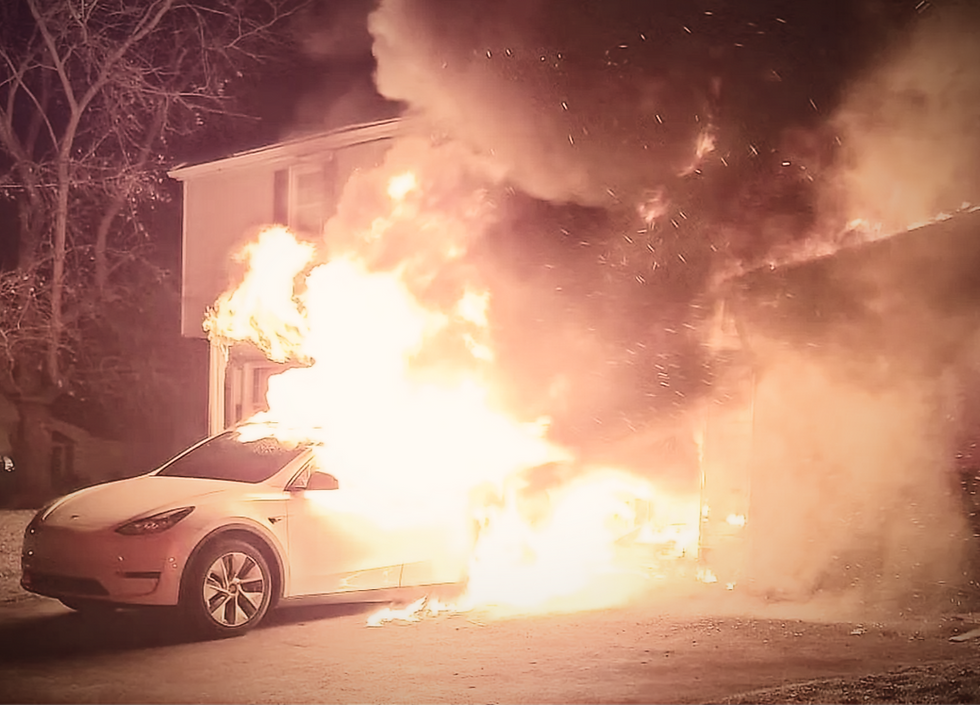You might be trading in your Tesla because of Elon Musk's public persona, but we are LA49 have looked into another Tesla issue. A rumor has been circulating in the wake of the Palisades Fire, which ravaged Pacific Palisades starting January 7, 2025, suggesting that Tesla car batteries played a significant role in the blaze’s ferocious spread. The fire, one of California’s most destructive, torched 23,707 acres, leveled 6,837 structures, and claimed 12 lives, leaving residents and observers grasping for answers. The notion that Tesla’s lithium-ion batteries, known for their combustible nature, might have fueled the disaster has sparked curiosity, especially given the affluent neighborhood’s likely high concentration of electric vehicles. But after digging into reports, talking to sources, and sifting through the evidence, it’s clear this theory doesn’t hold much water—here’s why Tesla batteries likely didn’t make the Palisades Fire any worse.

The fire erupted in the Santa Monica Mountains under brutal conditions: Santa Ana winds roaring at up to 60 miles per hour and a landscape so parched it was practically begging to burn. Official updates from CAL FIRE paint a picture of a blaze driven by nature’s fury, sweeping through Pacific Palisades, Topanga, and Malibu with terrifying speed. Investigators are still piecing together the exact cause—some point to a possible reignition of an earlier fire, others to human activity—but nowhere in the early findings does the idea of Tesla batteries pop up as a culprit. Instead, it’s the classic wildfire recipe of wind and dry brush that seems to have set the stage for this tragedy.
The rumor hinges on Tesla’s batteries being some kind of fire accelerant. Lithium-ion batteries, the kind powering those sleek electric cars, can indeed catch fire under the right (or wrong) circumstances—think a crash or a short circuit—and when they do, they burn hot and stubborn. Firefighters have noted they’re a pain to put out, needing loads of water to cool down. It’s not hard to imagine why someone might connect the dots: Pacific Palisades, with its wealth and eco-conscious vibe, probably has more Teslas per block than your average suburb. Could a bunch of them catching fire have turned a bad situation into a catastrophe?
To get a clearer picture, I looked at what the data says about electric vehicle fires in general. Studies—like one from IEEE Spectrum a couple of years back—show that EVs are actually less likely to ignite than gas-powered cars. Gasoline vehicles had something like 1,530 fires per 100,000 sold, while pure EVs clocked in at just 25. Sure, when an EV battery does go up, it’s a tougher fight for firefighters, but that’s more about containment than causing a wildfire to explode across thousands of acres. The Palisades Fire wasn’t a few cars sparking in a garage—it was a wind-driven beast tearing through hillsides.
What about specifics from the scene? Reports from the ground don’t point to Tesla batteries as a major player in the fire’s spread. CAL FIRE and outlets like The New York Times have stuck to the narrative of natural forces at work, with no mention of electric vehicles fanning the flames. Where Teslas and their batteries do come up is after the fact, during the cleanup. Articles from LAist and Fox News highlight how the sheer number of burned-out EVs—Teslas included—complicated debris removal. An EPA official called it the biggest lithium-ion battery cleanup they’d ever tackled, with damaged batteries posing risks of toxic leaks or reignition. That’s a headache for recovery crews, no doubt, but it’s a far cry from those same batteries turbocharging the fire as it roared through.
Social media has been buzzing with speculation, naturally. One X post I came across from a user named @alexdatig floated the idea of EV batteries contributing to “Class D” fires—those involving metals—while another from @gotemgoddard claimed Teslas would make any blaze “burn hotter and longer.” It’s the kind of chatter that spreads fast, but it’s light on evidence. Firefighters quoted in places like the Financial Post did say lithium batteries kept fires near homes burning longer, but that’s more about isolated hotspots, not the wildfire’s overall path. Jalopnik even warned about abandoned EV batteries turning cleanup into a “nightmare,” yet again, that’s post-fire, not during the blaze itself.
Stepping back, the scale of the Palisades Fire makes it hard to pin much on a handful of car batteries, Tesla or otherwise. This wasn’t a slow house fire—it was a wind-whipped inferno that didn’t need extra fuel to devour everything in its way. The real story here seems to be the same one California knows too well: dry seasons, fierce winds, and a spark that got out of hand. The Tesla rumor might make for a juicy headline, but it doesn’t match the facts rolling in.
For a place like Pacific Palisades, where electric cars are a common sight, this kind of clarity matters. People deserve to know what really happened without getting tangled in myths—especially when rebuilding lives and homes is the focus. The evidence points to nature, not Teslas, as the driving force behind this disaster. That’s not to say EV batteries are risk-free; they’ve got their own challenges, as the cleanup crews can attest. But as for making the Palisades Fire worse? It looks like that’s one rumor we can put to rest.

Comments